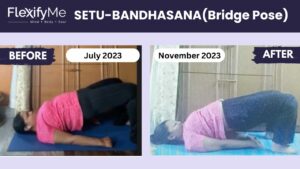Managing chronic pain conditions is an uphill battle not just physically but financially. Between healthcare appointments, medications, alternative treatments, and inability to work full-time, the costs rapidly accumulate into a major economic burden. Recent studies estimate the average out-of-pocket costs for a chronic pain patient range from Rs. 50,000 to well over Rs. 4,00,000 annually according to Harvard Health Publishing, creating significant financial stress.
When Riya, a 28-year-old graphic designer living in Bangalore first developed fibromyalgia, her rising medical bills from consultations, pain medications, acupuncture and physical therapy felt endless. Each treatment provided only mild temporary relief of stiffness and pain points across her body, with symptoms worsening over time. Unable to sit at a computer for long stretches to work, Riya drained her savings account within two years.
“Making appointments with top specialists so frequently meant missing client deadlines, until I lost major accounts,” she explains. “Working odd freelance gigs still didn’t balance my health costs and regular expenses. My focus shifted from graphic design dreams to just fighting for basic functional ability day-to-day.”
Riya’s story resonates with millions struggling to stay afloat while managing a range of chronic pain disorders like migraines, arthritis, sciatica, and more. From expensive diagnostic tests to prescription pain relief experiments that simply don’t work reliably, patients sink deeper financially and emotionally just to function.
In this blog series exploring the monetary crisis within India’s chronic pain problems, we investigate the systemic flaws and offer practical solutions for improving access. Why should only those able to spend thousands monthly out-of-pocket receive treatment to reduce suffering? Creating a working model that eases this fiscal burden fuels hope for the future.
Stay tuned for financial analysis on the most prohibitively costly pain treatments, policy recommendations to improve affordability and access to care, and strategies for decreasing financial stress.
Analyzing the Costs of Medications and Medical Treatments
Skyrocketing Costs of Medications
The exponential rise in prices for even generic pain relief medications presents a massive barrier to effective chronic pain management. Non-steroidal anti-inflammatory drugs like ibuprofen that temporarily ease inflammatory conditions like arthritis have nearly doubled in price over a 5-year period. The newer nerve pain medications like gabapentin cost over INR 500 per month – unreasonable for long term use.
Bipasha Roy, a pharmacist at Apollo Pharmacy in Hyderabad explains, “Even the basic pain relief drugs are inflating in cost. So patients try stretching prescriptions by taking smaller doses or skipping refills which then reduces efficacy. It becomes a choice between managing budgets and managing pain.”
## Mounting Bills for Medical Procedures
In addition to prescription costs, interventional treatments to diagnose nerve-related pain and joint injections for orthopedic conditions rack up hefty bills over time driving patients into debt.
Take the example of Debjani Das from Poland struggling with chronic lower back and hip pain for years without clear diagnostic imaging results. Just the MRI neurography procedure necessary to pinpoint nerve compression setting off her sciatic pain ran INR 35,000.
“The imaging tests to guide the doctors cost as much as several months of groceries and utilities,” remarks Debjani. “Never-ending treatment expenses haunt patients considering the frequent trial-and-error nature of chronic pain relief.”
We must push healthcare policy reforms to control inflated pricing on essential pain medications and diagnostics so patients can access relief without sacrificing necessities. In the meantime, exploring lower-cost alternative pain therapies shows promise until the system too eases this massive monetary burden.
The Role of Complementary Therapies in Pain Management
Exploring Integrative Solutions
With medication expenses and repeat procedures often cost-prohibitive for long-term pain care, many patients turn to alternative modalities either alongside or instead of conventional treatment. Natural solutions like acupuncture, massage, mindfulness, and targeted nutrition carry minimal costs while producing measurable pain relief and restored ability to function according to the National Center for Complementary and Integrative Health.
Dr. Radhika Kaple, an occupational therapist from Pune, incorporates **yoga for chronic pain** reduction in her rehabilitation programs. She remarks, “Simple pranayama and gentle movements ease muscle tension safely with zero financial burden. Once patients practice positional adjustments to protect vulnerable areas, many reduce painkiller use.”
Lifestyle-Based Healing
Policy makers drafting affordable, accessible chronic care models increasingly point to lifestyle changes emphasizing mental health and movement as vital for pain mitigation with limited healthcare expenditure required. National Institute of Health studies confirm pain conditions show significant improvement through adopting **holistic health solutions** including:
– Yoga and stretching routines to improve mobility and strength
– Mindfulness training and **meditation for chronic pain** modulation
– Improved sleep hygiene
– Personalized nutritional strategies to reduce inflammation
Such modifications prove not only clinically effective but foster patient empowerment over their healing journey compared to passive medication dependence. With abundant free resources for incorporating lifestyle adjustments, self-directed care bears great promise easing fiscal trauma.
Patient-Driven Communities
Peer communities for chronic pain patients act as rich self-help ecosystems where people share DIY solutions using limited resources. 41-year-old Suhasi Rao living with fibromyalgia finds guidance and comfort interacting with chronic pain groups: “We collectively strategize everything from nursing career adjustments to home remedy Alternatives for pain episodes when pharmaceuticals become financially difficult. There’s so much wisdom within lived journey.”
As medical bills drive families into debt traps, leveraging holistic health knowledge and community wisdom helps chronic pain patients rewrite their narratives.
Cost-Effective Strategies in Managing Chronic Pain
The last decade ushered encouraging tech-led innovations easing economic burden for chronic pain patients through affordable self-care alternatives. AI-powered mobile apps deliver personalized treatment replacing pricey clinical visits while telehealth allows remote pain consulting.
FlexifyMe leverages adaptive AI for chronic pain management care. Their app analyzes patient metrics including pain triggers, lifestyle factors and medical history to create customized physical therapy routines, meditation schedules, and nutrition plans for just INR 499 a month.
FlexifyMe user Tasneem shares, “The in-app coaching helped me strengthen weak muscles aggravating my back pain. I could affordably self-manage and avoid expensive chiropractor trips.”
Yoga Through Smart Devices
Online yoga providers like Zigyoga and **FlexifyMe** make therapeutic movement accessible using digital classes viewable on any budget smart device. FlexifyMe’s **360Flex approach to chronic pain** features customized video flows aligned to patients’ pain patterns, risk factors and fitness levels.
“I simply couldn’t afford regular physiotherapy. Now FlexifyMe’s specialized sequencing guides me to safely strengthen weakened areas and relax tense muscles from home,” remarks FlexifyMe member Suchita Nayak.
Remote Pain Management Consultations
FlexifyMe expands medical access points through virtual consultations with accredited pain specialists at lower costs. It connect patients in any location to doctors equipped to diagnose complex conditions and design affordable treatment protocols.
Chitrakoot-based teacher Aditi Kaushik struggling with shoulder impingement syndrome clarified her diagnosis quickly using FlexifyMe remote orthopedic experts. “It spared me years of guessing games and monumental medical fees,” she says.
Human centered technology innovations enhance equitable delivery caring for India’s millions battling relentless and expensive chronic pain battles. What further solutions can impact affordability? Share below!
Conclusion: Balancing Treatment Efficacy and Cost
The upsetting reality remains – left unaddressed, millions will continue struggling under the oppressive costs of life with chronic pain even as access to relief remains locked behind profit-driven systems.
However, technology now allows customized and affordable self-care. We must leverage tools like FlexifyMe’s AI-powered **yoga for flexibility and fitness** to protect recovering areas independently from home. Or tap into telehealth platforms connecting us to doctors able to diagnose complex conditions virtually under INR 1000.
Policy changes addressing inflated costs of essential medications also bear pursuing. With smarter advocates demanding affordable healthcare, we ease unconscionable trade-offs between financial security and simply functioning through daily tasks pain-free.
The ideal integrative model blends vital pain sciences with lifestyle wisdom on restorative movement, anti-inflammatory **nutrition**, and stress management for sustainable results. As patient Arijit Das from Kolkata reminds, “Healing cannot exist without hope fueling the journey.”
I urge anyone locked in struggles feeling isolated by the traumatic pain and money trap to reach out. Join online communities to exchange cost-saving hacks or begin small with 5 minutes of gentle yoga flows using apps seeking to make movement accessible across economic barriers.
Through compassion and collective voices, we can transform an otherwise isolating and expensive healthcare landscape into one focused on restored abilities to thrive in work, relationships and life pursuits not constantly clouded by pain’s shadow nor the looming stress of how to pay for relief.


